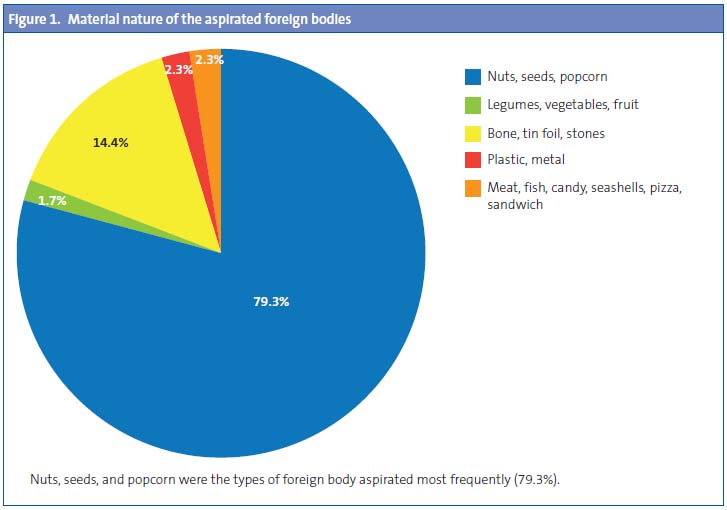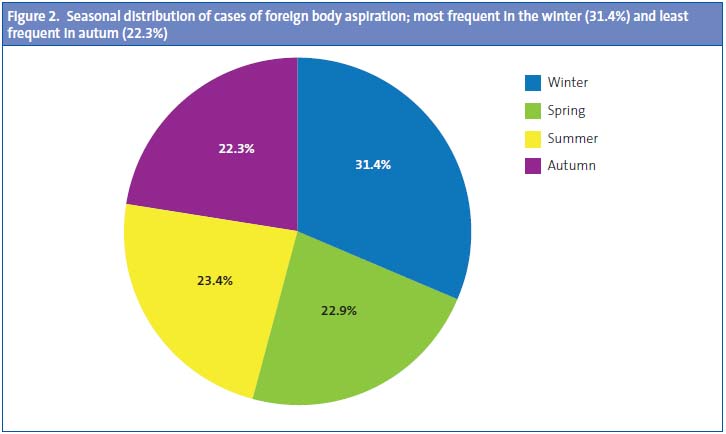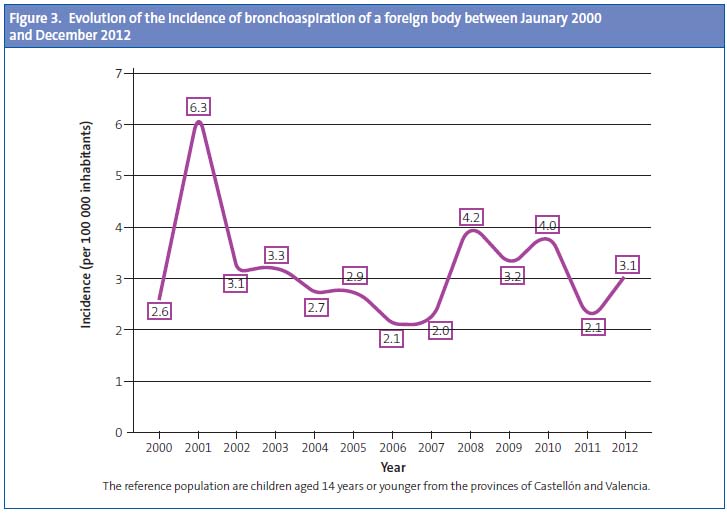Mi SciELO
Servicios Personalizados
Revista
Articulo
Indicadores
-
 Citado por SciELO
Citado por SciELO -
 Accesos
Accesos
Links relacionados
-
 Citado por Google
Citado por Google -
 Similares en
SciELO
Similares en
SciELO -
 Similares en Google
Similares en Google
Compartir
Pediatría Atención Primaria
versión impresa ISSN 1139-7632
Rev Pediatr Aten Primaria vol.16 no.63 Madrid jul./sep. 2014
https://dx.doi.org/10.4321/S1139-76322014000400003
Foreign body aspiration. An underestimated life-threatening problem
Aspiración de cuerpo extraño, un problema potencialmente letal menospreciado
A. B. Domènech, C. Gutiérrez, V. Ibáñez, J. E. Barrios, J. Lluna and J. J. Vila
Hospital Universitari i Politècnico La Fe. Valencia. Spain.
This study was presented at the 52 Congreso de la Sociedad Española de Cirugía Pediátrica (Congress of the Spanish Society of Paediatric Surgery), held in Palma de Mallorca in May 2013.
ABSTRACT
Purpose: to conduct a retrospective and analytical study of cases of foreign body (FB) aspiration over the last 12 years, assessing their impact, evolution and prevention.
Methods: we present 175 patients (112 male and 63 female) admitted to our hospital from January 2000 to December 2012 and diagnosed with clinically suspected foreign body aspiration (FB). The results are analyzed using Chi-square test and Mann-Whitney U test.
Results: the mean age was 3.3 years (SD: 2.1). Time delay until consultation to the ER was less than 3 days in 70.3% (123 cases). Nuts were the most frequent FB (79.3%). Complications at diagnosis: none (77.7%), pneumonia (21.1%), exitus (1.1%). We found a significant relationship between time delay until consultation and complications at diagnosis (Χ2=42.36; p=0.000), but there was no association between this time interval and the number of bronchoscopies needed for the extraction of the FB (U=3121.5; p=0.686). In contrast, time delay did influence the length of hospital stay (U=2521.5; p=0.025).
Conclusion: FB aspiration remains a serious and frequent problem in paediatric patients. The incidence has not declined over recent years, the highest being in 2001 (6.34 per one hundred thousand children under 14 from Castellon and Valencia) and the lowest in 2007 (2.04/100,000).
Key words: Aspiration. Bronchial foreign body. Bronchoscopy.
RESUMEN
Objetivos: realizar un estudio retrospectivo y analítico de los casos de aspiración de cuerpo extraño de los últimos 12 años, valorando su incidencia, su evolución y su prevención.
Material y métodos: se presentan 175 pacientes (112 hombres y 63 mujeres) visitados en nuestro hospital desde enero de 2000 a diciembre de 2012 con sospecha de aspiración de cuerpo extraño (CE). Se analizan los resultados mediante pruebas Ji-cuadrado (Χ2) y U-Mann-Whitney (U).
Resultados: la media de edad fue de 3,3 años (desviación estándar: 2,1). El tiempo de evolución hasta que acudieron a Urgencias de nuestro centro fue menor de tres días en el 70,3% (123) de los casos. El CE más frecuentemente broncoaspirado fueron los frutos secos (79,3%). El 77,7% de los casos no presentó complicaciones al diagnóstico, el 21,1% presentó neumonía y el 1,1% fue exitus. El análisis estadístico demostró una relación significativa respecto al tiempo de evolución y las complicaciones al diagnóstico (Χ2=42,36; p=0,000). Por el contrario, no existió asociación entre el tiempo de evolución y el número de broncoscopias necesarias para la extracción del CE (U=3121,5; p=0,686). En cambio, el tiempo de evolución sí influyó en la duración de la estancia hospitalaria (U=2521,5; p=0,025).
Conclusiones: la aspiración de CE es un proceso frecuente y con complicaciones graves. La incidencia no ha disminuido a lo largo de estos últimos años, siendo máxima en el año 2001 (6,34 casos por 100 000 habitantes) y mínima en el 2007 (2,04/100 000 habitantes).
Palabras clave: Aspiración. Cuerpo extraño bronquial. Broncoscopia.
Introduction
Aspiration of a foreign body (FB) continues to be a frequent problem in the paediatric age group, and can have severe consequences.1 It is a medical emergency that requires an early diagnosis and urgent initiation of treatment.2 It is the second leading cause of death in the home in children one to three years of age.
The lack of knowledge on this subject in households and even schools is worth noting. For instance, in autumn, when the production of nuts rises, the consumption of chestnuts, walnuts, and other nuts traditionally increases in schools and childcare centres, with the resulting increase in risk that this entails for children. Furthermore, these organisations often hold chestnut or nut festivals this time of year, during which children get to eat these foods.
International recommendations vary widely in regards to the age at which nuts should be introduced in the child's diet. The stance of the Spanish Association of Primary Care Paediatrics (Asociación Española de Pediatría de Atención Primaria [AEPap]) is that it "unequivocally discourages feeding nuts to children younger than five or six years", the Spanish Association of Paediatrics (Asociación Española de Pediatría [AEP]) states that nuts are not recommended before three years of age due to the risk of choking and asphyxia.3 Organisations such as the American Academy of Pediatrics (AAP)4 set the minimum age on 4 to 6 years. Canada5, Australia2,6 and New Zealand7 have agreed on a minimum age of 5 years. California, however, has set a lower limit at four years.9,10
Materials and methods
We included all cases of aspiration of a FB that occurred from January 2000 to December 2012 in the provinces of Valencia and Castellón; and made a retrospective analysis for a total of 175 patients (112 male and 63 female).
The variables analysed were sex, date of birth, date of the aspiration episode, date of hospital admission, type of FB, complications at the time of diagnosis, number of bronchoscopies needed to extract the FB, location of the FB, and date of discharge.
All patients included in the study underwent a bronchoscopic examination of the airways (under general anaesthesia and with a rigid bronchoscope [Storz®], using direct visualisation or a telescopic camera for image magnification). The FB was extracted using rigid forceps.
We performed a descriptive analysis of the variables mentioned above, and then used the chi squared test (Χ2) to analyse the association between the elapsed time from aspiration to diagnosis and the complications at diagnosis; and the Mann-Whitney U test to analyse the association between the elapsed time from aspiration to diagnosis and the required number of bronchoscopies, and the elapsed time from aspiration to diagnosis and the length of stay.
Results
The peak incidence occurred at 21 months of age (range, 7-164 months; mean, 39.1 months, standard deviation, 35.27), and the incidence was higher in boys than in girls (64% and 36%, respectively).
The diagnosis can be delayed for days or even months in the absence of clear clinical signs.6 The time elapsed until visiting our hospital was less than three days in 70.3% of cases (123 cases; range, 0-168 days). At diagnosis, 77.7% had not developed any complications, while 21.1% were diagnosed with pneumonia, and the remaining 1.1% died.
Bronchoscopy was the technique used for the diagnosis and treatment of AFB, and it allowed the successful extraction of the FB in every instance, although it had to be done more than once in some of the patients (85.1% needed a single bronchoscopy, and two cases [1.1%] required up to three bronchoscopies). Reviewing the FB extractions, we found that nuts were the most frequently aspired FBs (79.3%) in a wide range of objects and materials (Figure 1). The most common location of the FB was the right mainstem bronchus (RMB, 48.6%) (Table 1). We compared this proportion with the proportion of FBs found in the left mainstem bronchus (45.1%) and found no statistically significant difference between the two (95% confidence interval: -11.77-18.8).
Two patients died. One of them, a four-year-old girl, did not arrive in time to undergo a bronchoscopy; the autopsy determined that the cause of death was the presence of a metallic FB in the larynx. The other, a three-year-old boy, underwent a bronchoscopy that found a piece of bread in the RMB.
The length of stay was less than 48 hours in most patients, who were monitored with a physical and a radiological examination 24 hours after bronchoscopy and did not require further testing. Patients were held in the Paediatric Intensive Care Unit in the hours that followed bronchoscopy, where they received adjuvant treatment such as bronchodilator drugs and inhaled corticosteroids, respiratory physical therapy and intravenous antibiotics. The length of stay was of only 24 hours in 20.6% of patients, of 48 hours in 26.3%, and longer in the rest.
The seasonal incidence showed that, despite our observations in the introduction regarding autumn parties in schools and child care centres, only 22.3% of the bronchoaspiration episodes took place in autumn. The cases were fairly evenly distributed throughout the year (Figure 2).
Finally, we performed an analysis to study the relationship between the time elapsed from aspiration to diagnosis and the complications found at diagnosis. We did it by applying the Χ2 test to two binary variables (complications at diagnosis: yes/no; time elapsed from aspiration to diagnosis: longer or shorter than 72 hours), and found a statistically significant association (Χ2=42.36; df = 2; P = 0.000), by which the longer the time elapsed from aspiration to diagnosis, the more probable it is that the patient has complications at the time of diagnosis.
The analysis by means of the Mann-Whitney U test (U) between the time elapsed from aspiration to diagnosis (longer or shorter than 72 hours) and the number of bronchoscopies needed to extract the FB showed an independent correlation (U = 3121.5; P =.686). Conversely, the binary variable of time elapsed from aspiration to diagnosis had a significant influence in the length of stay (U = 2521.5; P =.025).
A total of 175 patients were admitted, with a mean incidence of 14.58 cases per year. Last of all, we used data from the Instituto Nacional de Estadística (National Statistics Institute)11 to analyse the evolution of the incidence of FB aspirations. Using data for the population of children aged 14 years or younger in the provinces of Castellón and Valencia (all of these cases were referred to our centre, which is the referral hospital for Paediatric Surgery and has the equipment, facilities, and trained healthcare staff needed to manage this pathology available), we determined the incidence per 100 000 inhabitants (Figure 3). The highest incidence corresponded to 2001 (6.34 cases per 100 000 inhabitants) and the lowest to 2007 (2.04 cases per 100 000 inhabitants).
Discussion
Foreign bodies in the respiratory tract are a significant health problem in children, with its incidence peaking between one and three years of age. Most of these episodes occur in the home, and they are more frequent in males.
Nuts are the material aspirated most commonly. They usually lodge into the RMB, and less frequently in the left mainstem bronchus, the larynx, the trachea, or both bronchi. Our study did not find a significant difference between the two bronchi, although due to its anatomical arrangement the incidence for the RMB is expected to be higher. The location, shape, and size of the object, as well as the age of the child, are the main factors that determine the clinical presentation, and the classic triad of symptoms is cough, wheezing, and hypoventilation in the affected side.12
Bronchoscopy is a delicate procedure that must be performed by an experienced hand. Bronchoscopic examination did not lead to complications in any patients in our study, but it can cause significant injury in the respiratory tract, so these patients must be referred to hospitals with trained staff13 and a Paediatric Intensive Care Unit with specialised paediatric bronchoscopy and anaesthesia teams, as the interaction between the anaesthesiologist and the bronchoscopist is crucial in these procedures. In our series, only 1.1% of patients with aspiration of a FB died after bronchoscopy.
Aspiration of a FB is a frequent event that may have severe complications and can always be avoided if the right preventive measures are taken. Surprisingly, its incidence has not declined in recent years, with the highest incidence occurring in 2001 (6.34 cases/100 000 inhabitants) and the lowest in 2007 (2.04 cases/100 000 inhabitants).
Prevention is of utmost importance, and is clearly a cornerstone in the fight against this health issue. We need to have more prevention campaigns, given the potential severity of this entity. We propose that products are labelled appropriately to warn of the potential dangers of nuts, as it is done in toys that contain small parts.
Acronyms:
FB: foreign body • RMB: right mainstem bronchus • U: Mann-Whitney U • Χ2: chi squared.
![]() Correspondence:
Correspondence:
Anna-Betlem Domènech:
annadomenechtarrega@gmail.com
Bibliography
1. Barrios JE, Gutiérrez C, Lluna J, Vila JJ, Poquet J, Ruiz-Company S. Bronchial foreign body: should bronchoscopy be performed in all patients with a choking crisis? Pediatr Surg Int. 1997;12:118-20. [ Links ]
2. Altmannn A, Nolan T. Non-intentional asphyxiation deaths due to upper airway interference in children 0-14 years. Inj Prev. 1995;1:76-80. [ Links ]
3. Polanco Aullé I. Alimentación del niño en edad preescolar y escolar. An Pediatr, Monogr. 2005;3:54-63. [ Links ]
4. Committee on Injury, Violence, and Poison Prevention. Prevention of choking among children. Committee on injury, violence and poison prevention. Pediatrics. 2010;125:601-7. [ Links ]
5. Well beings: a Guide to promote the physical health, safety and emotional well-being of children in child care centres and family day care homes, Vol. 1 & 2. Ottawa Ont.: Canadian Pediatric Society; 1992. [ Links ]
6. Altmann AE, Ozanne-Smith J. Non-fatal asphyxiation and foreign body ingestion in children 0-14 years. Inj Prev. 1997;3:176-82. [ Links ]
7. HealthEd. Helping New Zelanders stay well (en línea) (consultado el 23/07/2014). Disponible en: www.healthed.govt.nz/resource/starting-solids. [ Links ]
8. Emedicinehealth. Choking (en línea) (consultado el 23/07/2014). Disponible en www.emedicinehealth.com/choking/article_em.htm. [ Links ]
9. Hayes N, Chidekel A. Pediatric choking. Del Med J. 2004;76:335-40. [ Links ]
10. Brown II JM, Padman R. Case study of a UFO (unidentified foreign object). Pediatr Asthma Allergy Immunol. 2003;16:187-92. [ Links ]
11. Inebase. Instituto Nacional de Estadística (en línea) (consultado en abril de 2014). Disponible en www.ine.es/jaxi/menu.do?type=pcaxis&path=/t20/e245/p08/&file=pcaxis. [ Links ]
12. Pérez M, Carballo I, García M, Ramil C, Quiroga E. Aspiración de cuerpos extraños. An Esp Pediatr. 1996;44:453-5. [ Links ]
13. Barrientos Fernández G, Matute Cárdenas JA, Romero Ruiz R, García Casillas M, Sánchez Martín R, de Agustín Asensio J, et al. Niña de 19 meses con neumonías de repetición. An Pediatr (Barc). 2000;53:383-4. [ Links ]











 texto en
texto en 





